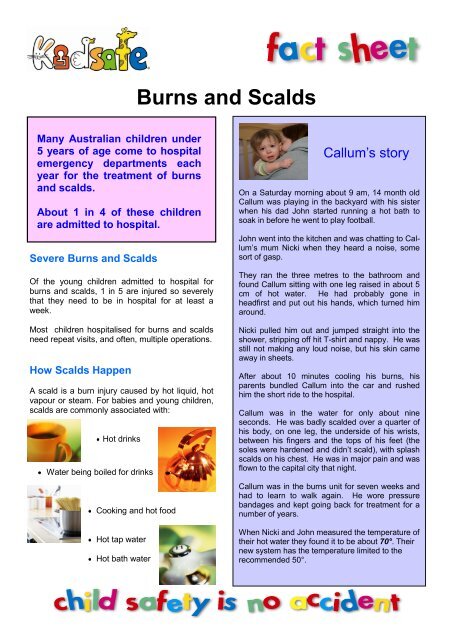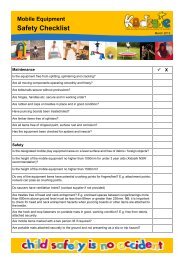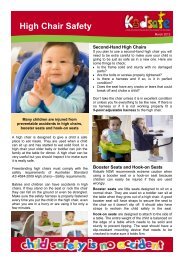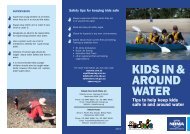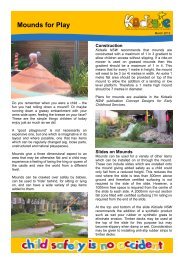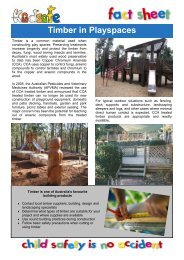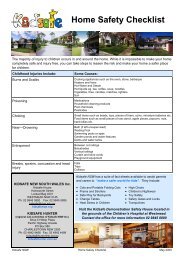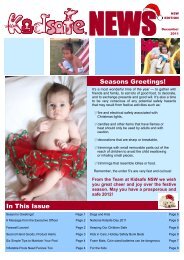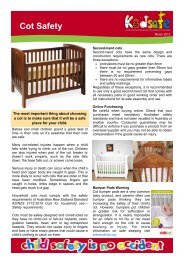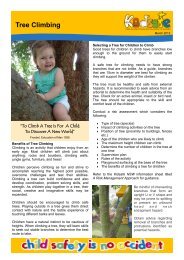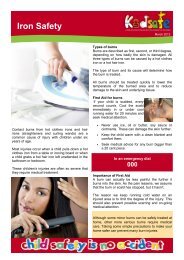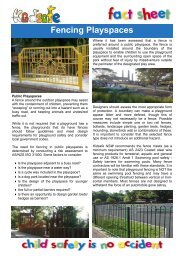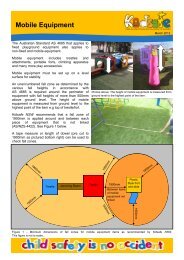Burns and Scalds - Kidsafe NSW
Burns and Scalds - Kidsafe NSW
Burns and Scalds - Kidsafe NSW
Create successful ePaper yourself
Turn your PDF publications into a flip-book with our unique Google optimized e-Paper software.
Many Australian children under<br />
5 years of age come to hospital<br />
emergency departments each<br />
year for the treatment of burns<br />
<strong>and</strong> scalds.<br />
About 1 in 4 of these children<br />
are admitted to hospital.<br />
Severe <strong>Burns</strong> <strong>and</strong> <strong>Scalds</strong><br />
Of the young children admitted to hospital for<br />
burns <strong>and</strong> scalds, 1 in 5 are injured so severely<br />
that they need to be in hospital for at least a<br />
week.<br />
Most children hospitalised for burns <strong>and</strong> scalds<br />
need repeat visits, <strong>and</strong> often, multiple operations.<br />
How <strong>Scalds</strong> Happen<br />
A scald is a burn injury caused by hot liquid, hot<br />
vapour or steam. For babies <strong>and</strong> young children,<br />
scalds are commonly associated with:<br />
Hot drinks<br />
Water being boiled for drinks<br />
<strong>Burns</strong> <strong>and</strong> <strong>Scalds</strong><br />
Cooking <strong>and</strong> hot food<br />
Hot tap water<br />
Hot bath water<br />
Callum’s story<br />
On a Saturday morning about 9 am, 14 month old<br />
Callum was playing in the backyard with his sister<br />
when his dad John started running a hot bath to<br />
soak in before he went to play football.<br />
John went into the kitchen <strong>and</strong> was chatting to Callum’s<br />
mum Nicki when they heard a noise, some<br />
sort of gasp.<br />
They ran the three metres to the bathroom <strong>and</strong><br />
found Callum sitting with one leg raised in about 5<br />
cm of hot water. He had probably gone in<br />
headfirst <strong>and</strong> put out his h<strong>and</strong>s, which turned him<br />
around.<br />
Nicki pulled him out <strong>and</strong> jumped straight into the<br />
shower, stripping off hit T-shirt <strong>and</strong> nappy. He was<br />
still not making any loud noise, but his skin came<br />
away in sheets.<br />
After about 10 minutes cooling his burns, his<br />
parents bundled Callum into the car <strong>and</strong> rushed<br />
him the short ride to the hospital.<br />
Callum was in the water for only about nine<br />
seconds. He was badly scalded over a quarter of<br />
his body, on one leg, the underside of his wrists,<br />
between his fingers <strong>and</strong> the tops of his feet (the<br />
soles were hardened <strong>and</strong> didn’t scald), with splash<br />
scalds on his chest. He was in major pain <strong>and</strong> was<br />
flown to the capital city that night.<br />
Callum was in the burns unit for seven weeks <strong>and</strong><br />
had to learn to walk again. He wore pressure<br />
b<strong>and</strong>ages <strong>and</strong> kept going back for treatment for a<br />
number of years.<br />
When Nicki <strong>and</strong> John measured the temperature of<br />
their hot water they found it to be about 70°. Their<br />
new system has the temperature limited to the<br />
recommended 50°.
Hot Drink <strong>Scalds</strong><br />
Hot drink scalds usually involve a young child<br />
pulling a cup down on itself; pulling down on a<br />
tablecloth that causes a drink to fall; or running<br />
into or being held by someone who has a drink<br />
<strong>and</strong> spills it.<br />
Injuries are usually to the head, face, chest <strong>and</strong><br />
h<strong>and</strong>s.<br />
Hot drink scalds can happen quickly, often with<br />
adults nearby who do not realise a child is<br />
reaching for the hot drink until it is too late to stop<br />
them.<br />
Children aged 1 to 2 years are most likely to be<br />
scalded in this way.<br />
Hot Tap Water <strong>Scalds</strong><br />
The bathroom accounts the majority of hot tap<br />
water scalds.<br />
<strong>Scalds</strong> are caused by hot water already in a<br />
bathtub, e.g. when a child falls or is placed into it,<br />
<strong>and</strong> when a child is in the bath <strong>and</strong> the hot water<br />
is turned on. <strong>Scalds</strong> can also occur in the shower<br />
<strong>and</strong> the h<strong>and</strong> basin.<br />
<strong>Scalds</strong> in the Kitchen<br />
Many scalds occur in <strong>and</strong> around the kitchen<br />
when younger children pull down hot items, or<br />
slightly older children try to “help”.<br />
Electric kettles pulled by the cord, saucepans or<br />
cooking implements pulled by the h<strong>and</strong>le, <strong>and</strong><br />
plates of hot food on the table are often involved.<br />
These scalds can involve relatively large<br />
amounts of very hot liquid falling onto the child’s<br />
head <strong>and</strong> upper body.<br />
Microwave ovens are involved in a<br />
large number of scalding incidents.<br />
This is because microwave ovens heat<br />
unevenly <strong>and</strong> may contain ‘hot spots’<br />
that will burn a child’s mouth.<br />
Noodles<br />
Spilling noodles heated in a<br />
microwave oven can cause burns to<br />
children.<br />
Noodles are a great snack especially for school<br />
aged children when they have arrived home from<br />
school or playing sport or from just playing.<br />
If a hot noodle attaches itself to the skin it will<br />
stick, making it hard to remove immediately. This<br />
allows the noodle to burn into the skin longer <strong>and</strong><br />
deeper. If placed into a child’s mouth the same<br />
burn can occur.<br />
Safe Practices<br />
Heat noodles under adult supervision<br />
Ensure noodles are not overheated <strong>and</strong> never<br />
boiled<br />
When microwaving noodles, be careful of<br />
uneven heating of food<br />
Older children should be taught the correct<br />
use of the microwave oven or stove, under<br />
adult supervision<br />
Heated noodles should be removed carefully<br />
from the microwave oven or stove either by<br />
an adult or under adult supervision<br />
Noodles should be allowed to cool before<br />
given to a child or eaten<br />
Baby Bottles<br />
Microwave ovens used for heating<br />
babies’ or young children's<br />
milk or food can cause scalds to<br />
the mouth that need extensive<br />
medical attention <strong>and</strong> may create<br />
permanent long term medical<br />
problems.<br />
Safe Practices<br />
According to <strong>NSW</strong> Health, breast milk <strong>and</strong> infant<br />
formula do not have to be warmed before feeding.<br />
Often, infants prefer to drink milk at room<br />
temperature.<br />
The best <strong>and</strong> safest way to warm bottles is by<br />
st<strong>and</strong>ing the bottle in warm water. It is not<br />
recommended to heat bottles in the microwave<br />
oven..<br />
Specially designed bottle warmers are also<br />
available. Test heated milk or water until it is warm<br />
to touch when sprinkled onto your wrist. While the<br />
bottle is warming remember to place the hot<br />
container in the sink or a safe place where<br />
children cannot access it.
Prevention<br />
Young children love to explore, touch, climb <strong>and</strong> grab, but do not underst<strong>and</strong><br />
dangers like hot water or hot drinks. Here are some ways to keep them safe from<br />
burns <strong>and</strong> scalds:<br />
Safety in the Kitchen<br />
Keep young children out of the kitchen or cooking<br />
areas during meal preparation.<br />
Keep kettles, jugs <strong>and</strong> teapots away from the<br />
edge of benches <strong>and</strong> tables.<br />
Use cordless kettles, curled cords or hook<br />
cords up to keep them from dangling within children’s<br />
reach.<br />
Empty kettles immediately after use.<br />
Install a stove guard to prevent children pulling<br />
objects off the cook top.<br />
Use an oven guard to limit heat from oven door.<br />
Turn saucepan h<strong>and</strong>les away from the stovefront.<br />
If possible, use the rear hot plates on the<br />
stove, rather than the front ones.<br />
Carry plates to the stove, rather than the saucepans<br />
to the plates.<br />
Safety with Hot Tap Water<br />
Control the temperature of your bathroom hot tap<br />
water to a maximum of 50°C. This temperature<br />
is required for new homes under the plumbing<br />
code. Your licensed plumber can tell you how<br />
best to achieve this.<br />
Always test the water’s temperature before<br />
bathing a child. Use the inside of your wrist.<br />
Hold it in the water for a slow count of five. It<br />
should be comfortably warm, not hot. Note: the<br />
maximum recommended temperature for bathing<br />
a baby is 38°C.<br />
When running a bath always run the cold water<br />
first (<strong>and</strong> turn it off last).<br />
Child resistant taps/tap covers can help, but<br />
won’t stop a child falling into a bath that is<br />
already run.<br />
Always stay with children when they are in the<br />
bathroom. Take them with you if you have to leave<br />
the room. Avoid leaving younger children in the<br />
care of older children.<br />
Turn taps off, tightly, <strong>and</strong> keep the bathroom door<br />
closed when not in use.<br />
Safety with Hot Drinks<br />
Keep hot drinks out of reach. Place drinks up<br />
high, rather than on low tables. At the table, use<br />
non-slip place mats rather than tablecloths, <strong>and</strong><br />
keep drinks toward the centre.<br />
Avoid feeding or cuddling your baby when having<br />
a hot drink. Take tea breaks when your toddler is<br />
resting or sleeping.<br />
Use a stable, broad-based<br />
mug.<br />
Avoid putting hot drinks in a<br />
cup your child usually drinks<br />
from, or allowing your child to<br />
sip from your hot drink.
General Prevention from burns <strong>and</strong><br />
scalds around the home<br />
Prevent chemical burns by wearing gloves <strong>and</strong><br />
other protective clothing when you h<strong>and</strong>le<br />
chemicals. Store chemicals, including petrol, out<br />
of the reach of children.<br />
To prevent electrical burns, put covers on any<br />
electrical outlets that are within children's reach.<br />
Throw out electrical cords that are frayed or<br />
damaged in any way.<br />
Use space heaters carefully <strong>and</strong> teach children to<br />
stay away from them.<br />
Store matches <strong>and</strong> lighters in a locked cabinet or<br />
where children can't reach them.<br />
Never leave c<strong>and</strong>les unattended. Blow them out<br />
when you leave the room.<br />
If you smoke, don't smoke in bed. Get rid of used<br />
cigarettes carefully. Fires caused by smoking<br />
materials are the leading cause of deaths in house<br />
fires.<br />
Before putting a child into a car seat, touch the<br />
seat to see how hot it is. Hot seat-belt straps or<br />
buckles can cause burns on small children. Cover<br />
the car seat with a towel when you park in the<br />
sun.<br />
Don't let small children play near the stove when it<br />
is in use.<br />
Don't wear clothing with long, loose sleeves when<br />
you are cooking.<br />
Cooking fires are the leading cause of house fires.<br />
Put out a small fire on a stove by sliding a lid over<br />
the flames.<br />
Do not use a microwave oven to warm baby<br />
bottles. The liquid may heat up unevenly <strong>and</strong><br />
scald your baby’s mouth.<br />
Cover electrical outlets to prevent electrical burns<br />
in babies, toddlers <strong>and</strong> small children.<br />
Unplug hot irons, such as clothes irons or curling<br />
irons, <strong>and</strong> keep them out of reach of children.<br />
For more information visit the<br />
Children’s Hospital at<br />
W e s t m e a d w e b s i t e —<br />
chw.edu.au<br />
<strong>Kidsafe</strong> <strong>NSW</strong> has a brochure<br />
available titled—<br />
Hot Water burns like fire.<br />
To order a copy, contact the<br />
office 02 9845 0890.<br />
First Aid for<br />
<strong>Scalds</strong><br />
If your child is scalded, every second counts.<br />
Remove all wet clothing. Any wet clothing left<br />
on the child will keep burning <strong>and</strong> cause more<br />
damage. Leave clothing on if stuck to the<br />
skin.<br />
Run cold water over the burn for 30 minutes.<br />
Never use ice, oil or butter, soy sauce or<br />
ointments. These can damage the skin<br />
further.<br />
Keep the child warm with a clean blanket <strong>and</strong><br />
comfort them. Seek medical advice.<br />
Seek immediate medical advice if the burn<br />
involves the face or h<strong>and</strong>s, is larger than the<br />
child’s palm, or if blistering appears or scald is<br />
inside the mouth.<br />
In an emergency dial 000<br />
for an ambulance.<br />
KIDSAFE NEW SOUTH WALES Inc.<br />
<strong>Kidsafe</strong> House<br />
Hainsworth Street<br />
Locked Bag 4001<br />
WESTMEAD <strong>NSW</strong> 2145<br />
Ph: 02 9845 0890 Fax: 02 9845 0895<br />
kidsafe@chw.edu.au<br />
kidsafensw.org<br />
KIDSAFE HUNTER<br />
(regional sub-committee of <strong>Kidsafe</strong> <strong>NSW</strong> Inc.)<br />
Shop 5 Hilltop Plaza<br />
Pacific Highway Arcade<br />
PO Box 580<br />
CHARLESTOWN <strong>NSW</strong> 2290<br />
Ph: 02 4942 4488 Fax: 02 4942 4499<br />
kidsafe@hunterlink.net.au<br />
kidsafehunter.com.au<br />
<strong>Kidsafe</strong> <strong>NSW</strong> February 2010


